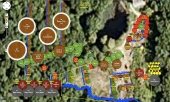
 2
2





[Tilling] removes the basis of civilization and of life itself. It is far worse than burning a city. A burned city can be rebuilt. A field that is washed away is gone for ages. Hence the Old World saying, "After the man the desert."





- Tim's Homestead Journal - Purchase a copy of Building a Better World in Your Backyard - Purchase 6 Decks of Permaculture Cards -
- Purchase 12x Decks of Permaculture Cards - Purchase a copy of the SKIP Book - Purchase 12x copies of Building a Better World in your Backyard




Moderator, Treatment Free Beekeepers group on Facebook.
https://www.facebook.com/groups/treatmentfreebeekeepers/





 1
1




Moderator, Treatment Free Beekeepers group on Facebook.
https://www.facebook.com/groups/treatmentfreebeekeepers/





 4
4








Moderator, Treatment Free Beekeepers group on Facebook.
https://www.facebook.com/groups/treatmentfreebeekeepers/






|
It is difficult to free fools from the chains they revere - Voltaire. tiny ad:
A PDC for cold climate homesteaders
http://permaculture-design-course.com
|


